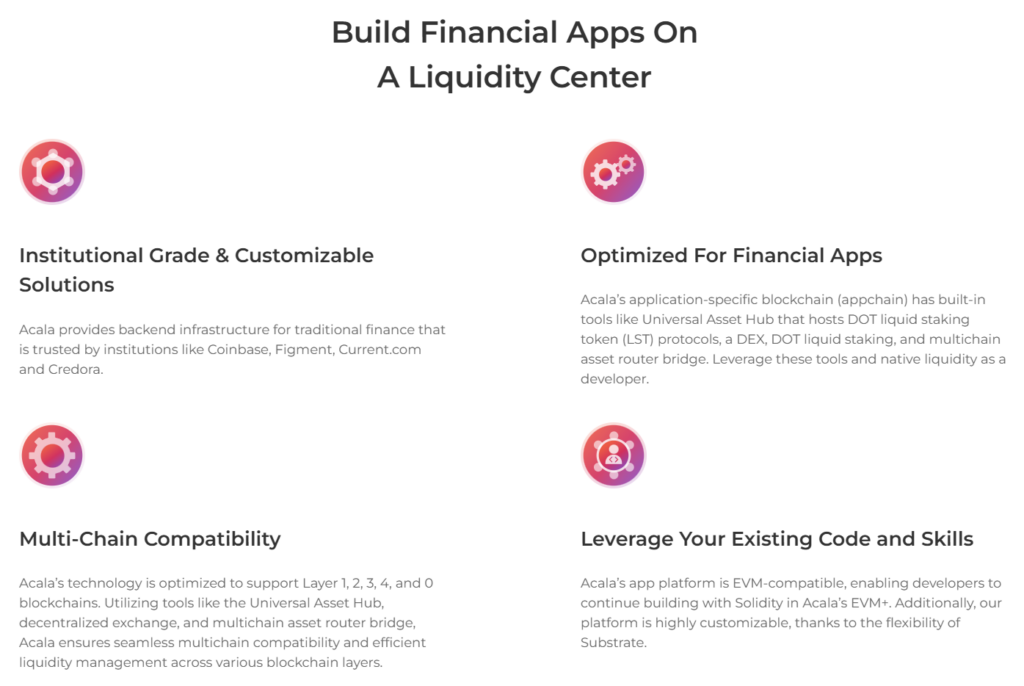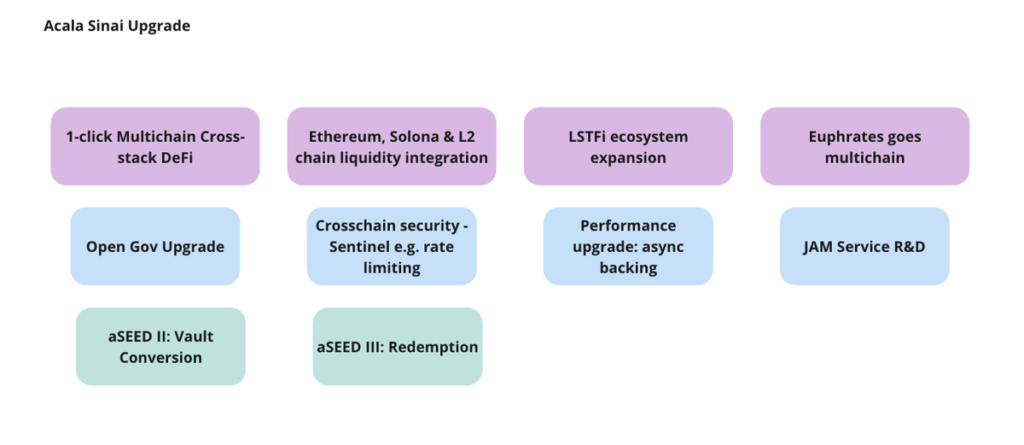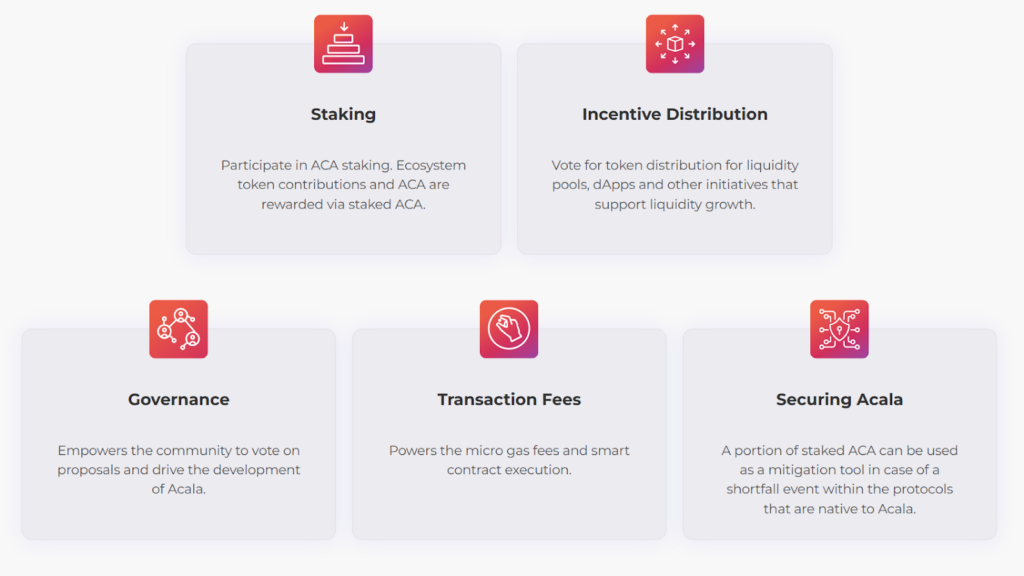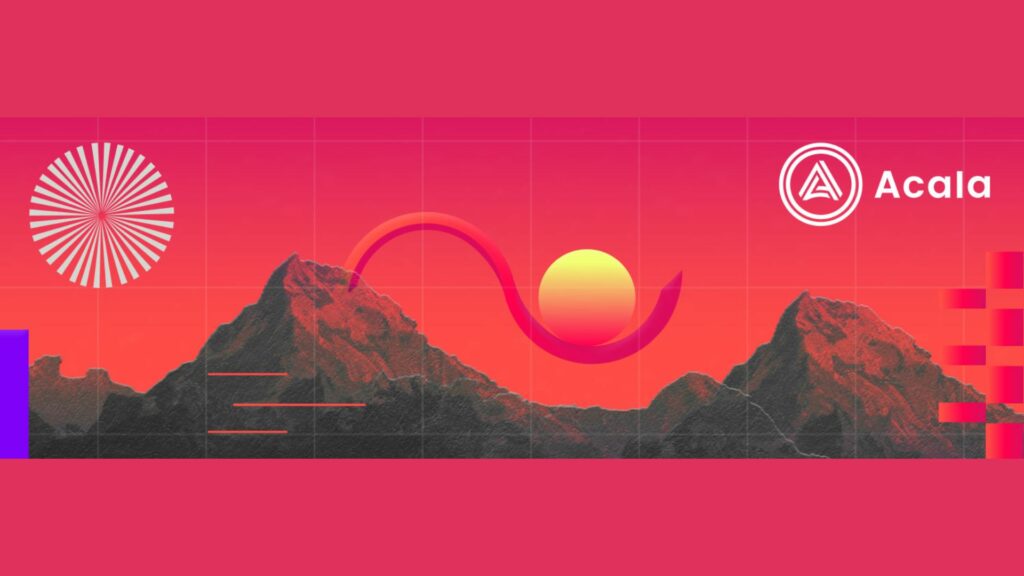Acala is a decentralised finance network on Polkadot that provides stablecoin infrastructure, staking, and cross-chain asset movement.
It supports financial activities like lending and liquidity provision, with a focus on multichain compatibility and decentralised governance.
This article explains what Acala is, how it works, its latest upgrade under Acala 2.0, how users can use it, how its token system functions, and what to expect from its roadmap.
What Is Acala?
Acala is a blockchain platform developed as a parachain on the Polkadot network. Its main purpose is to serve as a liquidity layer that connects various assets and protocols.

Source: Acala
It was created to allow users to mint and use a decentralised stablecoin, stake DOT while maintaining liquidity, and access financial services without relying on a single chain.
The project launched in January 2022, backed by over 32 million DOT during Polkadot’s parachain auction. This raised approximately $1.2 billion at that time.
Acala initially introduced a stablecoin called aUSD, which is now being replaced by aSEED through a phased conversion process.
The platform also introduced LDOT, a token that represents staked DOT, allowing users to earn staking rewards while using the asset in decentralised finance applications.
Acala is supported by the Acala Foundation and operates as an open-source network. It benefits from Polkadot’s shared security, allowing it to operate securely while integrating with other parachains and external blockchains.
How Its Infrastructure Works
Acala uses Polkadot’s shared security model and cross-chain messaging standard, known as XCM, to facilitate the movement of assets between chains.

Source: Acala
The network is maintained by collators who produce blocks and submit transaction data to Polkadot validators. This setup allows Acala to inherit Polkadot’s security while providing its financial applications.
The network supports two environments. The first is Substrate-native, which uses the Polkadot-specific development framework. The second is Acala EVM+, which is compatible with Ethereum smart contracts.
This dual setup allows developers to write applications in Solidity while gaining access to features not available on Ethereum, such as flexible transaction fees, built-in governance, and cross-chain functionality.
Users can mint LDOT by staking DOT through the Homa protocol. LDOT continues to earn staking rewards, estimated at around 5% to 7% annually, while being usable in other applications.
Acala also runs a decentralised exchange, supports lending and liquidity provision, and allows assets to be routed through its Multichain Asset Router. This router connects assets across different networks, including Ethereum, Solana, and Layer 2 chains using Wormhole.
Acala also offers a flexible transaction fee model. Users can pay fees using ACA, DOT, LDOT, or aSEED. If a user has no ACA, the network will automatically use the next available supported asset to complete the transaction.
The Acala 2.0 and Sinai Upgrade
The latest development phase for Acala is the Sinai Upgrade, which builds on the previous Exodus Upgrade. This marks a major step toward improving infrastructure performance, governance, security, and access to multichain finance.

Source: Acala
The Sinai Upgrade introduces one-click access to multichain decentralised finance, allowing users to interact with multiple chains through a single interface. This simplifies the experience for users and increases the efficiency of accessing DeFi services.
Acala is also integrating liquidity from Ethereum, Solana, and Layer 2 chains. This enables smoother asset transfers and creates access to a broader range of decentralised applications.
The upgrade also expands the LSTFi ecosystem. This includes new staking options such as LSDOT, tapETH, and tDOT, offering more ways for users to stake assets and earn yield.
The Euphrates application is being extended to work across multiple chains. Euphrates currently supports DOT-based staking vaults, but it will soon support Ethereum-based liquid staking tokens. This allows capital to move between chains more efficiently.
Acala is also adopting OpenGov, Polkadot’s on-chain governance model. This allows ACA holders to submit proposals, vote, and implement decisions without a central authority.
It also introduces sub-councils that manage specific parts of the network, such as the Homa Staking Council and the Financial Council.
Security is another focus. Acala is developing a cross-chain security tool called Sentinel, which adds features like rate limiting between parachains to prevent network abuse.
A performance upgrade called asynchronous backing is also being introduced. This allows for higher throughput by processing transactions in a non-linear manner, which supports better scaling for high-volume use.
Finally, the JAM Service research initiative is exploring how Acala can support future Polkadot technology, including the upcoming JAM chain. This ensures long-term compatibility and continued improvement of the network’s performance and developer tools.
How Users Can Interact With Acala
To start using Acala, users need a Polkadot-compatible wallet. You can use wallets such as Talisman, SubWallet or Polkadot.js for a more native experience, however, you can also use MetaMask or WalletConnect.
Once connected, they can obtain ACA tokens to pay for transaction fees or use other accepted assets like DOT or LDOT.

Source: Acala’s DApp
Users can stake DOT into the Homa protocol to receive LDOT. This token can then be used in liquidity pools, lending platforms, or the Acala Swap decentralised exchange. The staking process continues in the background, so users earn rewards while still using the token.
Users who held aUSD before its conversion now have aSEED. This token represents a claim on the underlying treasury and will become redeemable after certain conditions are met.
These include a holding period of 12 months and a minimum treasury value of $1 per aSEED. No action is needed from holders, but they can track the redemption proposals through on-chain governance.
Builders can deploy smart contracts using Solidity on Acala EVM+. Existing Ethereum applications can be adapted to work on Acala with minimal changes.
These applications can also access native Acala features, such as flexible gas fees and cross-chain asset routing.
The ACA Token Economics
ACA is the native token of the Acala network. It is used for governance, staking, transaction fees, and liquidity incentives. The total supply is capped at 1.6 billion ACA.

Source: Acala
Acala plans to release 100 million ACA annually for six years. Of this amount, 50% is allocated to staking rewards and 50% to liquidity farming and ecosystem incentives. ACA holders can vote to direct emissions toward specific dApps or liquidity pools.
To reduce inflation, Acala includes a burn mechanism. Each month, 1% of any unspent emissions is burned. Every six months, 20% of accumulated network fees are also burned.
Over time, this approach may lead to deflation, especially if adoption increases while emissions decline.
ACA staking earns between 6% to 8% annual returns. A portion of staked ACA can also be reserved to cover protocol shortfalls if needed, adding a layer of security to the ecosystem.
Conclusion
Acala is building a cross-chain financial network with the tools needed for secure and flexible asset management.
It combines staking, stable assets, decentralised exchange tools, and full governance features. With Acala 2.0 and the Sinai Upgrade, it is now more focused on multichain interoperability, efficient performance, and a user-governed system.
By relying on Polkadot’s security and expanding its connections to other networks, Acala provides a foundation for decentralised finance applications that aim to operate across multiple ecosystems.

